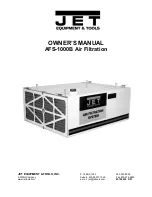
13
VI. INSTALLATION
A. GENERAL
1. PRE-INSTALLATION CHECK-POINTS — Before attempting any installation, care-
fully consider the following points:
Structural strength of supporting members
(Rooftop Installation)
Clearances and provision for servicing
Power supply and wiring
Gas supply and piping
Air duct connections and sizing
Drain facilities and connections
Location for minimum noise and vibration
2. LOCATION CONSIDERATIONS (CORROSIVE ENVIRONMENT)
The metal parts of this unit may be subject to rust or deterioration if exposed to a
corrosive environment. This oxidation could shorten the equipment’s useful life.
Corrosive elements include, but are not limited to, salt spray, fog or mist in seacoast
areas, sulphur or chlorine from lawn watering systems, and various chemical conta-
minants from industries such as paper mills and petroleum refineries.
If the unit is to be installed in an area where contaminants are likely to be a
problem, give special attention to the equipment location and exposure.
1. Avoid having lawn sprinkler heads spray directly on the unit cabinet.
2. In coastal areas locate the unit on the side of the building away from the water-
front.
3. Shielding by a fence or shrubs may give some protection.
1. Frequent washing of the cabinet, fan blade and coil with fresh water will remove
most of the salt or other contaminants that build up on the unit.
2. Regular cleaning and waxing of the cabinet with a good automobile polish will pro-
vide some protection.
3. Use a good liquid cleaner several times a year to remove matter that will not wash
off with water.
Several different types of protective coatings are offered in some areas. These coatings
may provide some benefit, but the effectiveness of such coating materials cannot be ver-
ified by the equipment manufacturer.
The best protection is frequent cleaning, maintenance and minimal exposure to
contaminants.
B. OUTSIDE INSTALLATION
(Typical outdoor slab installation is shown in Figure 5.)
1. Select a location where external water drainage cannot collect around unit.
!
WARNING
DISCONNECT ALL POWER TO UNIT BEFORE STARTING MAINTENANCE.
FAILURE TO DO SO CAN CAUSE ELECTRICAL SHOCK RESULTING IN PER-
SONAL INJURY OR DEATH.
!
WARNING
THESE UNITS ARE DESIGNED CERTIFIED FOR OUTDOOR INSTALLATION
ONLY. INSTALLATION INSIDE ANY PART OF A STRUCTURE CAN RESULT IN
INADEQUATE UNIT PERFORMANCE AS WELL AS PROPERTY DAMAGE.
INSTALLATION INSIDE CAN ALSO CAUSE RECIRCULATION OF FLUE PROD-
UCTS INTO THE CONDITIONED SPACE RESULTING IN PERSONAL INJURY
OR DEATH.
Summary of Contents for RRNL
Page 39: ...39 FIGURE 31 COOLING ON DELAY PROFILES INTERFACE BOARD SWITCH 7 8 7 8 7 8 7 8...
Page 40: ...40 FIGURE 32 BLOWER OFF DELAY PROFILES INTERFACE BOARD SWITCH 7 8 7 8 7 8 7 8...
Page 80: ...80 FIGURE 35 WIRING DIAGRAM XV WIRING DIAGRAMS...
Page 81: ...81 FIGURE 36 WIRING DIAGRAM...
Page 82: ...82 FIGURE 37 WIRING DIAGRAM 5 TON 4 TON LOW HEAT HIGH COOL 3 TON LOW HEAT MED COOL...
Page 83: ...83 FIGURE 38 WIRING DIAGRAM...
Page 84: ...84 FIGURE 39 WIRING DIAGRAM...
Page 85: ...85 FIGURE 40 WIRING DIAGRAM...
Page 86: ...86 FIGURE 41 WIRING DIAGRAM...
Page 87: ...87 FIGURE 42 WIRING DIAGRAM...
Page 88: ...88 FIGURE 43 WIRING DIAGRAM...
Page 91: ...91 FIGURE 46 SYSTEM CHARGE CHARTS RNL RPL 3 TON COOLING SYSTEM CHARGE CHART REFRIGERANT 410A...
Page 93: ...93 FIGURE 48 SYSTEM CHARGE CHARTS RNL RPL 4 TON COOLING SYSTEM CHARGE CHART REFRIGERANT 410A...
Page 106: ...106 15 SECOND PREPURGE FIGURE 61...














































